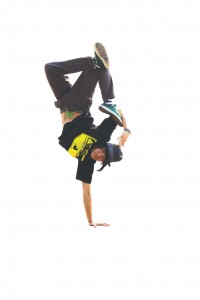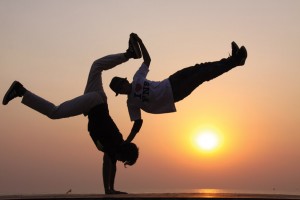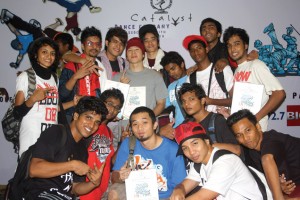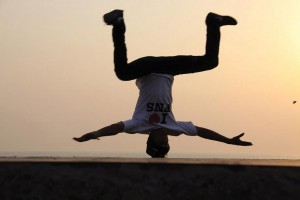 In the early 1970s, groups of youngsters took to the streets of New York to practice dance moves that blended intricate body movements, style, coordination and aesthetics. A significant part of the hip hop culture, this dance style came to be known as break dancing. An element of urban street culture, a form of expression for many and an art in its own right, the movement represented many things for different people.
In the early 1970s, groups of youngsters took to the streets of New York to practice dance moves that blended intricate body movements, style, coordination and aesthetics. A significant part of the hip hop culture, this dance style came to be known as break dancing. An element of urban street culture, a form of expression for many and an art in its own right, the movement represented many things for different people.
A Dance Revolution
Break dancing may have fizzled out, along with the good old boom box, but the b-boy lives on. What started off as a street dance culture in the African-American ghettos of the Bronx , gradually evolved into a slightly new variation called b-boying, or breaking, a dance form that spread across the globe faster than a virus, from America to Japan, China, Korea, Malaysia and India.
So how did this dance style reach Indian shores? Apart from the occasional exposure to b-boying on television and the Internet, ask anyone from the street dance community about the arrival of this art form in India and pat comes the answer Prosenjit Guy Kundu. Kundu started Syntheskillz, a community-based street dance project that promotes urban dance styles in India, along with his partner, Priya Lisa Gonsalves. Having trained the very first wave of b-boys in the country, he can be credited for the awakening of this scene.
Freak n Stylz, India’s first b-boying crew to break into the international arena, has been the pioneering force of this revolution in the country since 2007. In fact, the crew was started by A V Venkatesh, aka B-boy Young Soul who was inspired and guided by Kundu. Gautam Jeewan, the crew head of Freak n Stylz, says, “The crew has seen the growth of the b-boying scene in India from those days when only three or four b-boys existed, right up to today, when 800 to 1000 b-boys and b-girls are doing their thing. To be honest, the scene has exploded.” At this point in time, there are 30 crews in Mumbai itself. It has become all the rage with college students in the age group of 18-25.
Syntheskillz keeps this urban dance culture alive in the country through workshops, events and classes. The Freak n Stylz crew opened a dance academy as a way of earning a little extra pocket money soon after the crew was formed in 2007. Known as the Freak n Stylz Academy, it now has over 10 centres in Mumbai and Pune that train 400 people in the summer months alone!
 The Culture
The Culture
B-boying is one of the five pillars of the hip hop scene that represents just the dance aspect. The other elements that are a part of the hip hop manifesto include disc jockeying (music), graffiti (arts), rapping (voice) and knowledge (consciousness). The dancers are known as b-boys, short for break boys (correspondingly, b-girls refer to break girls). The term ‘break’ has its origins in the music that was played at the time. During the early days of b-boying, DJs looped the instrumental part of a song, known as a break, and incorporated this into songs allowing the dancers to showcase their dance moves. The music ranges from hip hop beats, to funk, soul and jazz. James Brown classics do it for the members of the Freak N Stylz crew.
So what exactly is it that urges dancers to be a part of this evergrowing cult? Primarily, it is the freedom to express themselves– be it in the form of funky attire, hair styles or crew names. Gautam’s b-boy name for instance, is B-boy ET, while others in the crew have names like B-boy FunkyMonkey, B-boy Fiend and B-boy YoungSoul. For many it’s the intricate and energising moves. For others, it’s the culture as a whole that acts as a magnet. For the Freakn Stylz crew in particular, it was the collective dance movies over the years that captured their imagination. This eventually led them to explore the underground world of b-boying via Youtube and other such resources
 Bust a Move
Bust a Move
To the mere spectator, b-boying might seem like it has its origins in another world altogether, what with its crazy, gravity-defying moves and the intensity of its dancers. But in actual fact, there is method in the madness. B-boying blends coordination, style, certain moves and aesthetics into energetic performances that never fail to enthral audiences. Some of the basic b-boying moves include Top Rock, Down Rock, Power moves (such as head spins and air flares) and Freezing (a freeze posture). Crews are known to practice for a minimum of three hours each day in studios, on beach promenades, pavements, terraces and the streets. “A typical practice session involves a lot of sweat, teamwork, thinking, learning, enjoying and staying together as a team,” explains Gautam.
Dance Floor Conversations
‘Battles’ are a huge part of the b-boy culture. Far from an actual battle, crews are known to take each other down on a one-on-one basis, each member coming up with a dance move better than the other. But aggression and one-upmanship are not common features of a b-boy battle. It’s all about perfecting one’s moves, coordination and aesthetics, offering quite a visual treat to the audience. Such competitions are something to look forward to in b-boy circles the world over. The Freak n Stylz crew, for instance, has participated in a good number of battles in India and around the world. “Winning the Battle of the Year India (BOTY India) qualifiers last year was quite an achievement for us because, in lay man’s terms, it is the World Cup of b-boying! Our crew became the first Indian crew to win the Indian qualifiers. Then we qualified for the South Asian qualifiers but stood 6th as the level there was obviously high,” explains Gautam. The crew also claimed the 6th place in BOTY South Asia that took place in Thailand. India too, has its fair share of b-boy battles. Amity University hosts the Respect B-Boy Circle, a contest many look forward to.
Travelling around the world plays a big role in the life of a b-boy or b-girl. “We travelled to Taiwan for three different dance jams in 2010, and to Thailand last year. We also went to Singapore in March this year. The experience is always good. You get to meet new people with the same drive and passion for dancing. Learning about different cultures is yet another boon. Plus, the food is amazing too! We’re planning more trips this year to other countries where there are good competitive events,” says Gautam, on behalf of the Freakn Stylz crew. Speaking about one of the most memorable moments in the crew’s history, he says, “There have been many such exciting times, but the most memorable one was when we had a street battle in the middle of the Bangkok Night Market with some of the local b-boys. It went on for about 30 minutes and we got a lot of appreciation from the local b-boys after the performance.”
Girl Power
It’s not just a male-dominated dance form, as you might have imagined. Girls are getting hooked to this dance form by the day and are taking it as seriously as any b-boy would. For instance, Shraddha, aka B-girl MuSick, is one of the few girls to have made this dance form a lifestyle. A part of the Freak n Stylz dance crew, she says that her favourite moment with the crew was when they travelled to Bangkok. The hotel was solely booked for the participating b-boys and b-girls, making it an exciting environment to be in.
 Slum Gods
Slum Gods
Interestingly, a dance form that had originated on the streets has been taken back to the streets. A large number of b-boy crews are mushrooming in places as unexpected as Mumbai’s Dharavi slum. The youngsters watch videos of their favourite b-boys from around the world on the Internet and learn new moves in the process. With all good intentions in place, the Tiny Drops Hip Hop Center was established in Dharavi some years ago by one of Mumbai’s famous b-boys, Netrapal Singh. With the aim to offer a space to underprivileged children to learn, practice and improvise on their hip hop dance moves, this center instils a sense of new-found confidence and empowerment by connecting youth to the international hip hop culture. The ability to pick up the moves came as a natural to many.
There continues to be a constant evolution of dance techniques and unique collaborations, reality dance TV shows and inter-collegiate festivals across India. From the looks of it, this urban dance phenomenon is certainly here to stay!
Volume 1 Issue 11



























